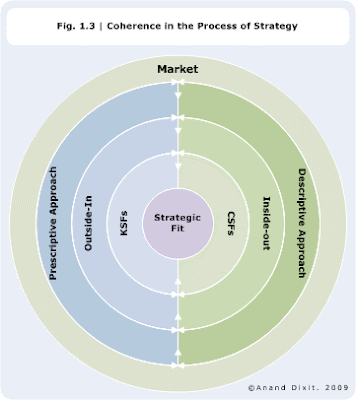I was listening to HBR’s Ideacast recently and came across an interesting idea by Booz & Company’s Paul Leinwand and Cesare Mainardi urging companies to “have the discipline to focus intensely on what they do best”. Titled the “Coherence Premium”, the central thesis of Leinwand and Mainardi is that “sustainable, superior returns accrue to companies that focus on what they do best”.
Gaining the Coherence Premium can be done if a company aligns and interlocks internal capabilities (or core competencies ala Hamel and Prahalad) with the right external market position. This can be graphically represented as follows:

Image source
According to the authors, the way to win in this game is by aligning the following:
The Way to Play
Executives, managers, and employees at every level should understand the way the company creates value for its customers (ie its market positioning). To do so, they should ask themselves the following questions:
- Are we clear about how we choose to create value in the marketplace?
- Are we investing in the capabilities that really matter to our way to play?
Capabilities System
The engine of value creation is the system of three to six capabilities that allow the companies to deliver their core value proposition (ie core competencies). This would involve finding answers to the following:
- Can we articulate the three to six capabilities that describe what we do uniquely better than anyone else?
- Have we defined how they work together in a system?
- Do all our businesses draw on this superior capabilities system?
- Do our organisational structure and operating model support and exploit it?
- Does our performance management system reinforce it?
Product & Service Fit
All products and services should leverage the same capabilities system (ie how systems, processes, policies and personnel fit together). The following questions on strategic fit would need to be answered:
- Have we specified our product and service “sweet spot” (aka USP)?
- Do we understand how to leverage the capabilities system in new or unexpected areas?
- Do most of the products and services we sell fit with our capabilities system?
- Are new products and acquisitions evaluated on the basis of their fit with the way to play and capabilities system?
Companies Practicing Coherence Premium
Examples of market leaders which has leveraged on the coherence premium include Coca-Cola, which stood out because of its intense focus on beverage creation, brand proposition and global consumer insight.
Wal-Mart’s superiority in retail was also attributed to its sheer focus on four capabilities: aggressive vendor management, expert point-of-sale data analytics, superior logistics, and rigorous working-capital management.
Companies with Incoherent Strategies
On the other hand, ConAgra Foods created incoherence by wrongly acquiring companies that do not fit into its capability sets. This resulted in poor corporate performance from 2002 to 2007.
A similar fate befell Anheuser-Busch when they launched Eagle Snacks, assuming that both beer and snacks are complementary to each other. Unfortunately, these adjacent products rely heavily on very different distribution capabilities. Anheuser-Busch does not have the right strengths or networks to compete in the latter market.
Ensuring Holistic Alignment of Strategies
The concept of alignment and focus isn’t new. In fact, it has been around for a long time.
Numerous business gurus have spoken about being focused, concentrating on your strengths, and aligning your enterprise in a singular direction. Sometimes, we’re told that we should zoom in on building on our strengths rather than to patch up our weaknesses.
What’s interesting about Booz & Co’s idea, however, is the insistence that a company should look deeper within to align every aspect of their organisation – marketing, HR and organisation, manufacturing, distribution, and so on – with what their inherent capabilities are.
Companies that seek to succeed must be somewhat ruthless in ensuring that every fibre of their organisation is aligned and coherent. It should be an integration of both inside-out and outside-in strategies as detailed below.

Courtesy of Anand’s Blog
While I do agree with the general approach embraced by both authors, the devil in discerning what forms one’s core capabilities (versus something periphery) is in the details.
Understanding what makes an organisation succeed in a marketplace requires a fair amount of investigation, intuition and insight. These go beyond a cursory look at why its succeeding and what its key capabilities leading to such wins were.
I’m also wary of business strategies that proposes too much “inward lookingness” and introspection. For sure, organisations should be careful about what they acquire or what business they go into so that they do not bite off more than they can chew. However, focusing too much on finding one’s own internal holy grail may result in one discarding fresh opportunities that are ready to be seized.
